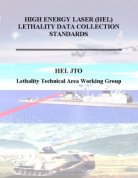
| |
DIRECTED ENERGY
PROFESSIONAL SOCIETY
|
|
|

Larger Image |
|
High Energy Laser (HEL) Lethality Data Collection Standards - Revision A
Nicholas J. Morley, Charles R. LaMar, J. Thomas Schriempf, Craig T. Walters, Robert F. Cozzens,
Brian J. Hankla, Jay Howland, William T. Laughlin, David N. Loomis, Robert Roybal, Barry Price,
Ralph R. Rudder, Stanley P. Patterson, and Joel S. Davis
Loose-Leaf Notebook
142 Pages
2008, Directed Energy Professional Society
Product Details
Table of Contents
Preface
|
| This book, as well as other books on Directed Energy,
are available from the DEPS online store. |
Product Details
High Energy Laser (HEL), lethality, and vulnerability data have been taken by various organizations
for more than 30 years. Well-substantiated data are pertinent and valuable to support service mission
lethality analyses versus threat targets of interest. However, a significant amount of this data is very
poorly characterized and not useable. This document describes a standardized methodology of collection
and evaluation of HEL lethality data including a description of certain experimental set ups. The principal
data of interest are the characteristics of the laser, the target, and the phenomenology being studied.
The data is classified into 4 categories including 1) laser beam properties, 2) target response, 3) test
stand/facility properties, and 4) target/test specimen characteristics with identified secondary data.
Standards under the first three categories are specified in a consistent format that covers the essentials
associated with the measurement: the purpose, the technical approaches to the measurement, calibration of
measurement hardware, data acquisition and logging, data reduction, and uncertainty of measurement results.
The format for data entry to a proposed future database is specified. Included is a brief summary of the
NIST guidelines for reporting uncertainty of measurement.
The main purpose of this standard is to provide guidance to those responsible for planning, performing, and
reporting laser lethality tests. It is not intended to provide a rigid format for the report, but to serve more
as a check list to make sure that the report contains sufficient information to enable users of the data to
make reliable lethality predictions now and in the future. The standard asks no more than good scientific
reporting, i.e., sufficient information that any skilled practitioner can reproduce the tests sufficiently to
expect the same results and that the results are well-characterized as to their uncertainty so that the
significance of differences seen by other experimenters can be quantified. The standard does offer more, in
that the specific requirements peculiar to laser lethality testing are discussed. The detailed information
provided in a report written under the standard will not only support the legitimacy of the results, but will
provide guidance to those wishing to perform similar measurements.
This is Revision A of this handbook. Please see the Preface for
more details on content of this product.
|

